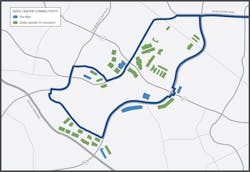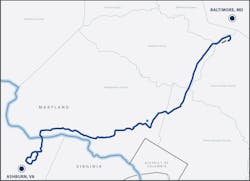DF&I CEO Scott Bergs Sheds Light On Dark Fiber Infrastructure Expansion In Top U.S. Data Center Markets
Given the perpetually expanding nature of the data center industry, fiber communications infrastructure, and particularly dark fiber route connectivity for expanding multi-tenant and hyperscale footprints, is for DCF somewhat in the category of a sequoia evergeen topic.
Just as much as factors of land, construction, power, leasing, cooling, sustainability, and IT, interconnection is a pillar of data center technology and business concerns, and dark fiber infrastructure developments for data centers account for a certain regular influx of news into the DCF editors' inbox.
As insatiable cloud computing platforms hunger for ever more network capacity to deliver data across their data center campuses, DCF has previously noted how dark fiber generally represents a hot commodity for data center investors.
How Dark Fiber Feeds Data Center Locations In Silicon Valley and Northern Virginia
Dark fiber is unused fiber optic cable that has been installed in underground conduits but not yet “lit” by connecting to network hardware and software that allows light to pass through the cable to carry data traffic. This dark fiber can be leased to add capacity on major fiber routes.
The top two U.S. locations for data centers, the greater Silicon Valley and Northern Virginia areas, are obviously focal points for dark fiber interconnect and deployment activities.
As a sampling of recent dark fiber doings in Silicon Valley, in late August, wholesale data center developer, owner and operator EdgeCore Digital Infrastructure Partners announced a new partnership with global communications infrastructure provider Zayo to bring dark fiber connectivity to EdgeCore's 72 MW Silicon Valley campus, whose groundbreaking was announced this January.
Zayo's Tier-1 fiber network inclues over 200 IP points of presence (PoPs) across the U.S., providing network infrastructure in advance to accommodate EdgeCore customers' evolving needs for scale, rapid deployment of additional bandwidth, cloud connectivity, customer end-point connectivity, etc.
"Zayo is excited to be a part of EdgeCore's expansion and provide the connectivity their customers need to be successful in today's digital business era," said Derek Gillespie, Chief Sales Officer, Enterprise at Zayo, who added, "As customer bandwidth demands increase with the rapid growth of technologies like AI, partnerships like this will be hugely important in providing the supporting infrastructure."
Looking across the country, July 2020 reporting by DCF's Rich Miller noted how investment firms with data center holdings were at that time ramping acquisition of dark fiber specialists, as the providers of the connective tissue for fast-growing hyperscale customers.
Two big moves in the cloud cluster in Northern Virginia were then the focal point of dark fiber M&A activity. For one, SDC Capital Partners acquired a majority stake in Summit Infrastructure Group (Summit IG), an experienced player in the fiber scene in Northern Virginia with more than 500 miles of fiber routes.
Also in 2020, IPI Partners acquired a majority position in Dark Fiber & Infrastructure (DF&I), which operates a fiber network in Virginia and Maryland.
DF&I Background and Recent Developments
DF&I was founded in 2017 to meet increased demand for dark fiber and conduit solutions in Northern Virginia, driven by the growing consumption of data center space and power in Data Center Alley.
IPI’s interest in DF&I was boosted by its use of the Potomac River Crossing fiber network to connect Northern Virginia’s Data Center Alley to a major Northeast U.S. telecom corridor. IPI invests in data centers and other technology and connectivity-related real assets and is co-sponsored by ICONIQ Capital, LLC and an affiliate of Iron Point Partners, LLC.
DF&I is now expanding its wholesale fiber networks farther into Maryland and Prince William County, Virginia, with a focus on providing turnkey access to some of the region's most prominent data centers, identifying efficient routes for interconnection while providing access rights, conduit, and dedicated fiber cables to data center operators and customers.
In January of 2022, DF&I announced the completion of a high capacity fiber route between Ashburn, VA and Baltimore and Linthicum Heights, MD. Completion of the 65-mile, ultra-low latency route established DF&I as a leading Mid-Atlantic communications infrastructure provider that can deliver dedicated dark fiber without the need for signal regeneration between southern Maryland and Ashburn’s major data centers.
DF&I's infrastructure offers more than 40,000 fiber strands between Maryland and Virginia and more than 70,000 fiber strands within its Virginia network. Boasting the most conduit capacity in the region, the DF&I Express Connect dark fiber network provides dedicated access to and between major data centers and peering points in and around the Ashburn area. The system includes a highly concentrated loop interconnecting Data Center Alley, and extends to the north on a direct route to Baltimore.
DF&I's network features a proprietary under-river crossing from Maryland to Ashburn, ensuring the most direct route that results in substantially lower latency for critical data. The DF&I Express Connect network's direct route traverses the Potomac River, avoiding congested data routes in Washington D.C. to provide customers with the fastest access to Ashburn from Maryland.
This May, DF&I announced that top global cloud and carrier-neutral data center, colocation, and interconnection solutions provider Digital Realty would bring two additional data center campuses on-net to DF&I's Express Connect dark fiber network, infrastructure which enables the peering and interconnection for a wide array of carriers, clouds, and data center operators, while providing a high capacity, open access data pathway between Northern Virginia and Baltimore, Maryland.
"By joining DF&I's Express Connect Network, our customers and providers have direct access into the region's most powerful dark fiber network and availability zone," said Corey Dyer, Chief Revenue Officer of Digital Realty. "Our relationship with DF&I aligns with our commitment to provide the most reliable data center and connectivity solutions to our customers, which in turn, strengthens the value of our partner ecosystem. This enables enterprises who are currently hosted in our Northern Virginia and Maryland data centers to accelerate their digital transformation journeys and eliminate complexity within their operations."
In June, DF&I announced that managed data center services provider DataBank had also brought its Ashburn campus on-net to DF&I's Express Connect dark fiber network. The system now connects DataBank's Ashburn campus which consists of two facilities with a combined 300,00 SF of raised floor space and 50 MW of critical IT load across 13 acres. The DataBank campus' location in the heart of Data Center Alley makes it a destination for premier enterprise, web-scale SaaS, or hyperscale cloud workloads looking for interconnection and expansion capabilities.
This August, DF&I also announced a continued advancement of its partnership with DataBridge Sites, a data center provider that supports off-site business critical IT environments. DataBridge earlier announced that it had added its Maryland facility on-net to DF&I's Express Connect network. Since the deal was originally announced nearly two years ago, the partnership has seen significant success. "Carriers continue rolling backbone traffic onto the Express as their new primary route into Ashburn, but also for direct underground connections north and east of the facility," noted DataBridge Sites CEO Jim Weller. "The feedback from our customers has been excellent, and we're proud to be able to offer this huge benefit."
Data Center Frontier's Interview with DF&I CEO Scott Bergs
Scott Bergs is the Chief Executive Officer of DF&I. He has over 30 years of experience in executive management, operations, sales and marketing, customer support, legal and regulatory support, fundraising, and M&A strategy and execution. His industry background spans data centers, fiber networks, wireless network operators, ISPs, and other critical communications infrastructure.
Prior to joining DF&I, Bergs served as CEO of communications infrastructure provider Vivacity Networks. Prior to Vivacity, he was the co-founder and CEO of Neutral Path Communications, a dark fiber and infrastructure provider that was successfully sold to Zayo Group.
Data Center Frontier sat down for an interview with DF&I CEO Bergs to discuss how the company expanding its wholesale fiber networks into Maryland and Prince William County, with a focus on turnkey access to data centers and identifying efficient routes for interconnection, while providing access rights, conduit, and dedicated fiber cables to data center operators and their customers, across a variety of relationships.
Bergs said DF&I's infrastructure development is an important go-to-market strategy for data center operators looking to diversify their revenue streams and bundle end-to-end services. He noted that DF&I focuses solely on infrastructure development to meet the growing needs of all classes of customers, while most communication service providers optimize for their retail and enterprise customer base.
In our talk, Bergs discerned the the parallel tracks of cloud and hybrid cloud migration driving demand for communications infrastructure, as well as the increasing need for infrastructure to support AI, and emphasized the benefits of controlling the physical layer of the network, including security, scalability, and latency improvements.
Data Center Frontier: Can you provide some background on DF&I and comment on recent data center partnerships in Ashburn and Maryland?
Scott Bergs, CEO, DF&I: DF&I was founded several years prior to that 2020 announcement. When IPI came in as the private equity funding partner, with their vast experience in the data center development part of the ecosystem and business, the goal was to scale the organization.
I actually joined about a little over a year and a half ago with the specific goal to just take what the original founders and the core team had already done by way of a great start of a network in and around Loudoun County and Ashburn proper, extending that up into the Baltimore area and then continuing to scale that.
We've done that in primarily two ways to date. The first is extending the network. In addition to the 65 mile expansion that we did up into the Baltimore area, we've also extended the network south and west through Prince William County, as the data center development continued to expand and explode into that area to reach those critical, both sole source and multi-tenant data centers in and around that area, to be able to serve all kinds of users.
That includes the data centers themselves, the hyperscalers that occupy those data centers, as well as the multiple tenants that exist within the multi-tenant data center facilities, and then beyond that, also the carriers.
As a pure play wholesale infrastructure developer and provider, we're creating networks that are trying to utilize the scarce right of way resource as efficiently and effectively as we possibly can, by making all of those facilities, including conduit dedicated cable as well as individual dark fiber pairs to any and all in the region on the most cost effective, right of way efficient and overall efficient basis. In so doing, we're architecting the network in a way that reduces latency and fail points by having the most direct routes.
That includes a proprietary and private easement river crossing across the Potomac to get us the most direct route between the Baltimore and Maryland markets, back into the Ashburn data center core, and then continues that same philosophy, as we expand through Prince William County with effectively two primary rings that extend down in that area.
That's the core network. The most recent announcements are equally exciting because as you go past those key data centers, the key is to get into them so that we can provide turnkey access, both for the single tenant locations as well as for all of the users of those multi-tenant data center locations. We've been very focused on continuing to expand those partnerships with those data center operators.
In the last three months alone, we've been able to turn up three new data centers with great partnerships with data center operators included in those announcements. So with Databank, DataBridge and DRT, it's just been expanding our network with great partnerships with superior data center operators and a lot more to come.
DCF: Seems like there's two halves of the strategy; expanding the dark fiber rings and then getting into the actual data centers. Is the dark fiber network itself still under construction beyond that 65 mile footprint, or is the focus now extending into those data centers?
Scott Bergs, DF&I: It's actually going in both directions. The original 65 miles expansion is done, completed, and we've now taken on more than doubling the size of that existing network as we continue to expand out to Leesburg, as well as out through Prince William County, as well as densifying within the core original network in Loudoun County. So that expansion continues, and then in parallel with that, we're extending with just building entrance facilities into multiple different data centers coordinated with those data center operators.
DCF: Can you help us understand from your perspective the conditions for demand? Obviously, the demand for data center connectivity in Northern Virginia is through the roof and it's bleeding over into Maryland. Can you explain a bit more in terms of what it takes to accommodate the interconnection needs of these big data centers?
Scott Bergs, DF&I: I think as most folks in this industry realize, Ashburn proper and Loudoun County and more generally, Virginia, have just been the largest data center cluster in the world, with just an enormous amount of the overall internet traffic of the world being processed and passing through the data centers in that specific corridor.
So demand continues to be high in and around that area from content providers, from the hyperscalers, as well as from carrier customers, to continue to serve the ever-expanding needs immediately within Data Center Alley.
But there's been continued development. We've reached near a saturation point of data centers in and around that primary Loudon County area. There isn't a lot of space, as well as the power providers have done to be able to support all those data center expansion needs. There's a need to expand out geographically, both up towards Maryland as well as a contiguous growth expanding out into Virginia through Prince William County.
What we do is to work very closely with the data center developers and operators to identify where that demand is going, and what the routes are that will be the most efficient means by which to interconnect those data centers to ultimately be able to serve the ever growing bandwidth needs of their customers.
DCF: In terms of the relationships that DF&I has with data centers, are you leasing the dark fiber capacity to them, and then they're leasing some of that capacity to their customers?
Scott Bergs, DF&I: To distill it down into the three most basic relationships: It can either be that we are acquiring just the access rights to get into their facility, and then within their meet me room we're serving their customer directly. So in other words, we're leasing facilities, and it could be entire conduits, it can be dedicated fiber cables or individual fiber strands to those data center operators and customers - that's flavor number one.
Flavor number two is that the data center operator wants to have their own fiber that they in turn can contract directly with their underlying customer. So we would provide: could be conduit, could be dedicated cable or individual fiber pairs, directly to the data center operator, who in turn bundles that with their space and power and makes it available.
Then thirdly, there might be a single tenant data center (for example, a hyperscaler) who would want a very specific architecture and design, and will provide that architecture and design end to end from the data center, all the way back to the other endpoints that they want to reach with dedicated facilities.
There's even more machinations. But those three cases really encapsulate the vast majority of the relationships that we've got with the data centers.
DCF: The next question is borrowed from DCF's present Executive Roundtable. What are your hottest U.S. data center markets, outside of the big two of Ashburn's Data Center Alley and Silicon Valley?
Scott Bergs, DF&I: Obviously, everyone's seen the enormous growth in and around Chicago, the enormous growth in and around the Columbus, Ohio area, and the enormous growth around Atlanta. We see that growth continuing to expand in those markets that have already seen a significant data center presence. Phoenix is another market that's had a significant amount of data center development.
Now, because we're in active negotiations on some of these projects with folks who haven't made their public announcements around where their data centers are going to go, I can't talk about very specific markets that we're going to directly participate in until we get to a time when we can make those announcements public.
What I can say is that it's an exciting time in the industry. Because as those workloads take hold, whether AI-driven or whether it's the continued evolution of the cloud migration, markets continue to press closer and closer to the edge or the 'eyeball' networks. That means that those smaller tier one markets haven't seen that much development from data centers and, consequently, the communications infrastructure is ripe for continued development.
We are looking at over 40 markets. Now we certainly are not going to deploy in anywhere near all of those 40 in the next couple of years, but we're actively looking at many markets across the United States.
The core for us is where the infrastructure does not exist, and where we can truly add value to the ecosystem, so that it enables the future and promise of the applications that are enabled by the combination of the data center and the communications infrastructure being in place.
That's where we want to go - and where somebody else is doing a great job, we'll move onto the next market.
In this video, DF&I's Co-Founder and Chief Revenue Officer John Schmitt sits down with JSA TV during Metro Connect 2022 to provide an update on the company's latest fiber builds.
DCF: What about our central contention that dark fiber for data centers is "a hot commodity?"
Scott Bergs, DF&I: Certainly many data centers are diversifying their revenue streams, but more importantly, bundling a complete end to end service. That includes space and power, but also the physical infrastructure that enables the communications between data centers.
We don't have a single strategy. What we are really focused on is placing infrastructure at the scale and architecture that enables the next generation of innovation to happen within those data centers by the data center operators themselves and their customers, by providing the best facilities on the most contractually flexible method that we can, with the most efficient routes. that deliver the lowest latency, at the most efficient cost possible. That's number one.
On the competitive side, there are others who do what we do, but very few across the country and even across the world that are just focused on the infrastructure development itself.
As we look into the expanded payloads like AI, and as the conversion to the cloud continues to expand for enterprises, government and others as they're moving into the cloud-based compute and storage models enabled in these data centers, it expands the amount of communications infrastructure required to make that all work.
We're here to just provide that core communications infrastructure on a purely wholesale basis so that we can unlock the value that they're going to bring to the market.
DCF: What separates DF&I from its competition?
Scott Bergs, DF&I: We've got a couple of real benefits in this game.
Number one is, IPI is a great partner. They've had a great depth of expertise and knowledge in their data center projects, both directly with their end customers, many of whom are hyperscalers, as well as through their portfolio company, Stack. Through that, we've been able to gain a lot of insights into what are the best areas to locate, what's the best architecture, and how best to work with those data center developers.
We've expanded that through the partnerships that we've already announced with Digital Realty, Databank, and DataBridge, and we're just continuing to do that wherever we can help those data center developers and operators achieve their goals.
The good news is, there's no sign of that slowing down anytime soon. We're just fortunate to have the economic support, the intelligence support of IPI, and a really strong operating team that allows us to meet and exceed the needs of those partners and customers.
DCF: What's the build-out of AI amid ongoing "cloudification" conditions going to look like for U.S. data centers in terms of interconnection?
Scott Bergs, DF&I: Silicon Valley, Ashburn, the greater Chicago area, Atlanta, Columbus, Dallas, there's a handful of those markets where lessons have been learned about how to architect the networks, about the placement of the data centers.
Historically, folks used optical networks to increase capacity, so they'd add greater bandwidth across the same limited dark fiber pairs. Now you're seeing that demand grow so significantly, that they need to have a higher count dedicated dark fiber facility in order to enable that AI, as well as the continued cloud migration and the application payload development that's happening in those markets.
It's a re-architecture, it's an expanded capacity, and it's a different model moving away from multiple gigs or multiple channels on a single pair of fiber to dedicated fiber cables, or even multiple conduit systems to enable that growth.
The added benefit that it provides is, now you've got a physical layer of security. Because now you control, usually by lease, that entire physical layer of the network, as opposed to just the optical layer, which has kind of been the historical norm, as people have just been buying turnkey bandwidth, as opposed to the physical infrastructure itself.
So the security benefits, the scalability of those benefits, as well as the benefits at the core latency all come together with great lessons learned from all those projects you've been tracking in Ashburn and in Silicon Valley and other markets over the last 10 to 20 years.
Keep pace with the fast-moving world of data centers and cloud computing by connecting with Data Center Frontier on LinkedIn, following us on X/Twitter and Facebook, and signing up for our weekly newsletters using the form below.

Matt Vincent
A B2B technology journalist and editor with more than two decades of experience, Matt Vincent is Editor in Chief of Data Center Frontier.







